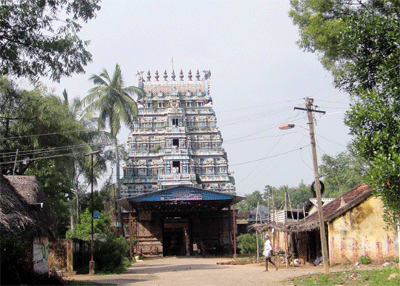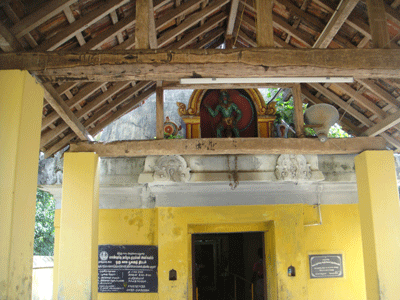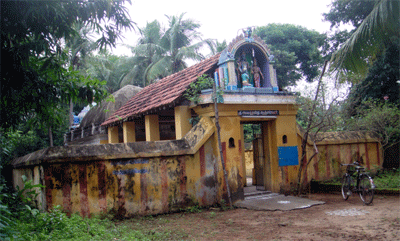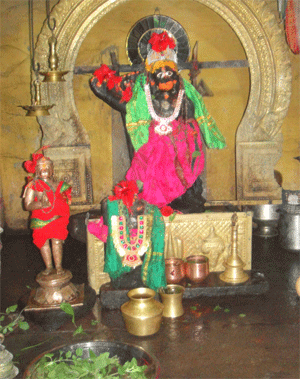
The river Kaveri
The river, Jeevanadhi Kaveri, originates in Kodagu, Karnataka. The place where the river originates is known as Tala Kaveri. After traveling around three hundred eighty-five KM, the river reaches Tamil Nadu at Hogenakkal near Mettur.
From Hogenakkal up to Bhavani the river runs southwards. The river Bhavani which originates southwest of Otty in the Nilgiri hill range amalgamates with Kaveri at the place called Bhavani. From there onwards the course of the river is eastwards and the Noyyal and Amaravati rivers also amalgamate with Kaveri. She becomes broader and the flow of the river is so majestic that the sight of it will make one spellbound. Near Tiruchirappalli Kaveri splits into two and the broader portion of the river assumes the name ‘Kollidam’. Kaveri and Kollidam continue their journey. While the Kollidam River runs parallel to Kaveri up to Kabisthalam, from thereon it changes its course and joins the Bay of Bengal east of Chidambaram. Kaveri continues its journey through Kumbakonam, Thirukodikaval, and Mayavaram and then enters the Bay of Bengal at Poompuhar.
These rivers make the Thanjavur delta region rich and fertile this delta is known as the ‘rice bowl of south India’.
Sacred Place
In sanatana dharma, all rivers are worshiped and are considered sacred. While all rivers are sacred, Ganga and Kaveri are worshipped as the most sacred rivers. Any river that takes a northward course at a particular place, then that particular place or location is treated as the most sacred kshetra. In the case of Ganga, Varanasi is the place where Ganga takes a northward course hence it is celebrated as the most sacred place. In the case of Kaveri, there is a kshetram ‘Thirukodikaval’ where the River Kaveri takes a northward turn.
Thirukodikaval
 This place is known for the famous Tiru Kodiswarar Temple. The temple is located on the banks of Kaveri which takes a northward turn from here. Nayanmargal Appar and Sambandar had sung in praise of the main deity of this temple Sri Kodiswarar.
This place is known for the famous Tiru Kodiswarar Temple. The temple is located on the banks of Kaveri which takes a northward turn from here. Nayanmargal Appar and Sambandar had sung in praise of the main deity of this temple Sri Kodiswarar.
The temple for Sri Kodiswarar was built by Pallava king Nandivarman in 750 AD. The brickwork of this temple had been reconstructed as a stone structure by Sembiyan Mahadevi, the mother of Uttama Chola in 979. The greatest service she had done was to reestablish all the inscriptions right from 750 AD to that day. The inscriptions thus reestablished by her had thrown a lot of light on the history of that period. These temple inscriptions are a treasure for the Archeologists and historians.
The agraharam of Thirukodikaval was a center of learning of Veda and Music. As every agraharam had a temple of its own, Thirukodikaval also had one. It is a temple for Sri Anjaneya who is a ‘nava-vyakarna pandit’ and an exponent of music.
Name significance
Tiri-koti means three crores. There are three crores of ‘Mantras’ [chanting the incantation] and each mantra has a deva. These three crore devas were very proud of their power. In arrogance, they even challenged Maharishi Durvasa that without their power nothing would fructify. In the course of the war of words, Maharishi Durvasa cursed these three crores devas. To redeem from the curse acquired by them they were asked to pray to Lord Siva on the bank of ‘uttravahini’ Kaveri. They located this kshetra where Kaveri was taking a northward course and worshiped Siva here.
 Since three crore Devas had prayed here to Lord Siva and got rid of the curse the deity is known and worshiped as ‘Kodiswara’. The kshetram got the name Tri-Kodi-Ka which in the later days came to be known as ‘ThiruKodikaval’.
Since three crore Devas had prayed here to Lord Siva and got rid of the curse the deity is known and worshiped as ‘Kodiswara’. The kshetram got the name Tri-Kodi-Ka which in the later days came to be known as ‘ThiruKodikaval’.
Village of Vedacharyas and exponents
This kshetra is where devas of Mantras got liberated from their pride, curse, and sins. Hence the pundits who are scholars of Veda had made this village their dwelling place. The rulers who were the patrons of Veda also helped considerably towards this goal. It is noteworthy that during Thanjavur Nayak’s rule and especially during Achuthappa Nayak and Raghunatha Nayak’s regime, many Vedic scholars and musicologists were patronized. Many scholars during this era with the patronisation of Govinda Dikshita, a minister of these two rulers, had come and settled in Thirukodikaval.
Agraharam and temple
Thus the agraharam of Thirukodikaval was a center of learning of Veda and Music. As every agraharam had a temple of its own, Thirukodikaval also had one. It is a temple for Sri Anjaneya who is a ‘nava-vyakarna pandit’ and an exponent of music [see ‘Hanumath veena’ in our site]. Naturally, these scholars of Veda and Music chose Sri Anjaneya as a deity for their worship.

Temple of Sri Anjaneya
The temple for Sri Anjaneya is at the entrance of the agraharam and very near Sri Kodiswarar temple. The temple is opposite to the village post office. The temple has a compound wall and is facing west. The entrance to the temple is through an arch which is crowned by Sri Rama Parivar stucco made using lime and mortar. As one enters the temple compound one can see a long tiled porch with a bali peedam in the middle. After this, there is a terraced mandapam which has an arch depicting Sri Anjaneya and then there is the garbhagraham. On the three sides of the vimanam, Bhakta, Sanjeevi and Veera Anjaneya statues are there. There is a Tulsi madam and a well from where water is drawn for pooja.

One can have the darshan of Sri Anjaneya from the entrance of the temple itself. As was the practice of those days, Sri Anjaneya of any ancient temple was named Sri Sanjeevirayar, so this temple deity was also known as Sri Sanjeevirayar. But today the temple is known by the name ‘Sri Abhaya hasta Anjaneyer kovil’. The ‘utsava moorti’ [Sri Bhakta Anjaneya] is also present in the garbhagraham.
Sri Anjaneya
Sri Anjaneya is inTribunga standing posture, looking graceful. Both His lotus feet adorn thandai and nupuramam. His hip is adorned with a decorative belt. His left hand is resting on the left thigh holding the stem of the sowgandika flower. The yagnopaveetam is seen across his chest. There are three malas on His neck. His stretched right hand is showing ‘abhaya mudra’. His face is slightly slanting rightwards and is bright. He is wearing kundalam in His ears, which are touching His shoulders. His kesam is neatly combed and braided. His eyes are glowing with mercy, blessing the devotee. The compassion thus showered can be felt in His presence by seeing His eyes.
Location of the temple: "Abhaya hasta Anjaneya Temple, Tirukodikaval, T. Nadu."
Experience
A prayer to Abhaya hasta Anjaneya, who showers compassion on His devotees, is bound to bring lasting happiness in one’s life.
SRI HANUMAN THINKS DIFFERENTLY, THINKS FAST
THINKS AHEAD AND ACTS FOR SURE
Ed [April 2020]
Updates: [Jan 2025]
